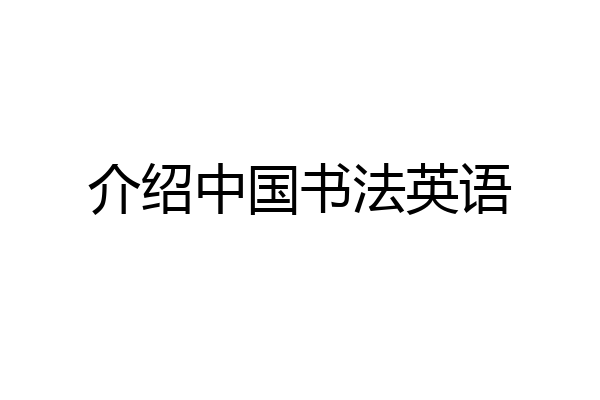
gaga1001mary
中国书法 Chinese Calligraphy Calligraphy is the essence of Chinese culture, which has developed into a special high-level art apart from satisfying the needs of daily writing. It has been flourishing for thousands of years inChina. Shops with strong commercial atmosphere will gain some elegance if they are decorated with some quaint cultural calligraphic works. Sitting rooms, studies and bedrooms can be nice-looking with calligraphy works decorated. As a kind of art work, the writing of calligraphy is particular. The Chinese characters are written on Xuan paper which absorbs ink very well and then are mounted to hang on a wall. The calligraphy works are mostly a poem or a motto that the host of the room likes it much; if it is written by the host himself, it will demonstrate more his aspiration and interest as well as his talent.


淡粉浅蓝
Names and featuresTraditional East Asian writing uses ink brushes to write Chinese characters. The way of writing is an one of the most important aspects of East Asian culture. Strictly speaking, it is not an art form, and therefore not calligraphy, that is, the art of writing. It is more accurately called a craft. However, it is normally referred to as calligraphy for the sake of convenience.Many East Asian calligraphic works are admired for their aesthetic appeal, which has led some to call it an art, especially outside the Sinosphere. The texts of calligraphic works are also admired and rigorously studied.Calligraphy has also influenced ink and wash painting, which is accomplished using similar tools and techniques. Calligraphy has influenced most major art styles in East Asia, including sumi-e, a style of Chinese, Korean, and Japanese painting based entirely on calligraphy.[edit] Historical evolution of Eastern calligraphyAncient ChinaIn ancient China, the oldest Chinese characters existing are Jiǎgǔwén characters carved on ox scapula and tortoise plastrons, because brush-written ones have decayed over time. During the divination ceremony, after the cracks were made, the characters were written with a brush on the shell or bone to be later carved.(Keightley, 1978).With the development of Jīnwén (Bronzeware script) and Dàzhuàn (Large Seal Script) "cursive" signs continued. Moreover, each archaic kingdom of current China had its own set of characters.Imperial ChinaIn Imperial China, the graphs on old steles — some dating from 200 BC, and in Xiaozhuan style — are still accessible.About 220 BC, the emperor Qin Shi Huang, the first to conquer the entire Chinese basin, imposed several reforms, among them Li Si's character unification, which created a set of 3300 standardized Xiǎozhuàn characters[4]. Despite the fact that the main writing implement of the time was already the brush, few papers survive from this period, and the main examples of this style are on steles.The Lìshū style (clerical script) which is more regularized, and in some ways similar to modern text, was then developed.Kǎishū style (traditional regular script) — still in use today — is even more regularized. The Kaishu shape of characters 1000 years ago was mostly similar to that at the end of Imperial China. But small changes have be made, for example in the shape of 广 which is not absolutely the same in the Kangxi dictionary of 1716 as in modern books. The Kangxi and current shapes have tiny differences, while stroke order is still the same, according to old style[5].Some Variant Chinese characters were unorthodox or locally used for centuries. They were generally understood but always rejected in official texts. These variants, in addition to some newly created characters, compose the Simplified Chinese character set.Cursive styles and hand-written stylesCursive styles such as Xíngshū (semi-cursive or running script) and Cǎoshū (cursive or grass script) are less constrained and faster, where more movements made by the writing implement are visible. These styles' stroke orders vary more, sometimes creating radically different forms. They are descended from from Clerical script, in the same time as Regular script (Han dynasty), but Xíngshū and Cǎoshū were use for personal notes only, and were never used as standard.Printed and computer stylesExamples of modern printed styles are Song from the Song Dynasty's printing press, and sans-serif. These are not considered traditional styles, and are normally not written.

shmilyflying
Easier - Calligraphy is the art of making beautiful or elegant handwriting. It is a fine art of skilled penmanship. Harder - The word calligraphy literally means beautiful writing. Before the invention of the printing press some 500 years ago, it was the way books were made. Each copy was handwritten out by a scribe working in a scriptorium. The hand writing was done with quill and ink onto materials like vellum or parchment. The lettering style applied was one of the period bookhands like rustic, carolingian, blackletter, etc. Today, there are three main types or styles of calligraphy: (1) Western or Roman, (2) Arabic, and (3) Chinese or Oriental. This project focuses mainly on Western calligraphy with a glimpse at the other two styles.